Embark on the Niederhorn Hike in Switzerland’s Bernese Alps for an unforgettable adventure. This scenic trek boasts breathtaking panoramas and a variety of wildlife. Begin your journey in Beatenberg or take the cable car to the Niederhorn summit. Along the way, you’ll traverse charming Alpine meadows and dense forests, and witness unparalleled vistas of Lake Thun and the awe-inspiring Bernese peaks.
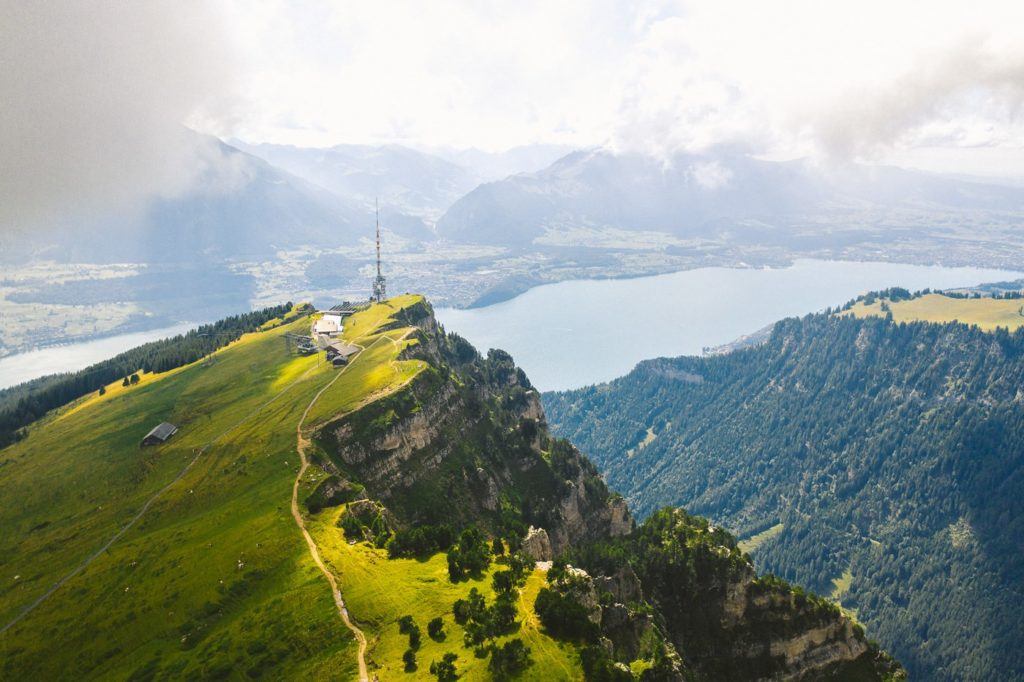
THE NIEDERHORN RIDGE TRAIL
The Niederhorn Hike leads you to a popular summit with lots of action at the time, highlighted by incredible views of Lake Thun. It’s possible to ride up or down with the cable car but exploring the Niederhorn ridge hike at the summit is a must!
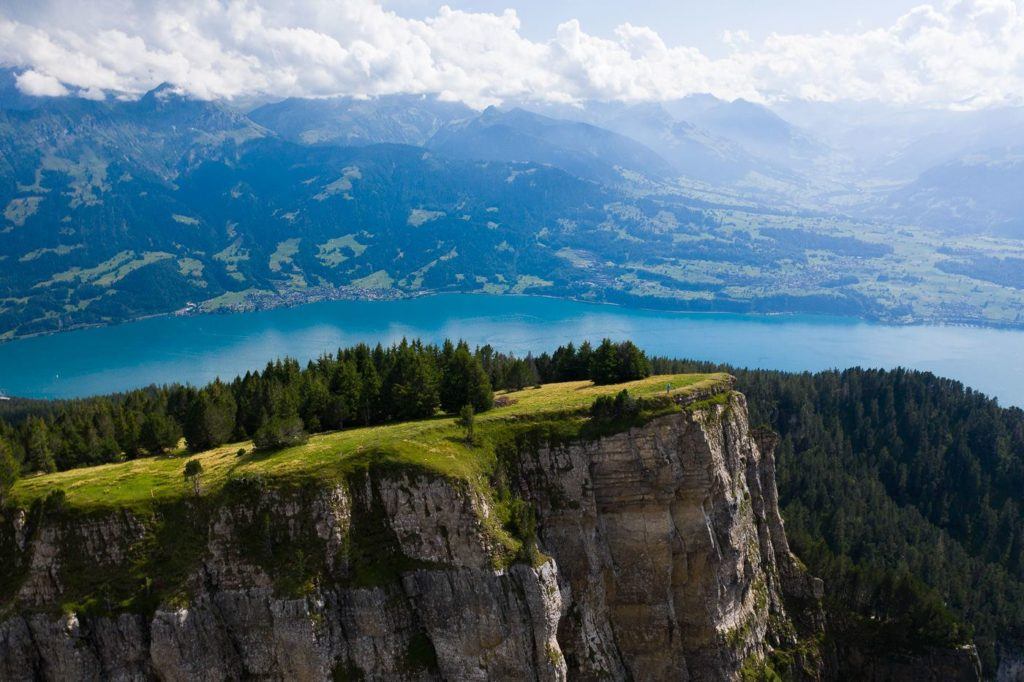
NIEDERHORN RIDGE HIKE DETAILS
- Hike Distance: The way we did the hike was to take a cable car to the summit and then hike along the ridge and then down to Beatenberg Station. This was 7 kilometers. It can be done in reverse or as an entire loop for 14 km.
- Hike Duration: The hike down took less than two hours but the hike up would take 2-3 hours.
- Hike Difficulty: Very low difficulty with clear path, signs, and no drop-offs.
- Hike Incline: Starting point at Beatenbergbahn: 1,126m – Niederhorn: 1,950m
YOU WILL ALSO LIKE MY SWITZERLAND HIKING GUIDE: 50 AWESOME HIKES IN SWITZERLAND
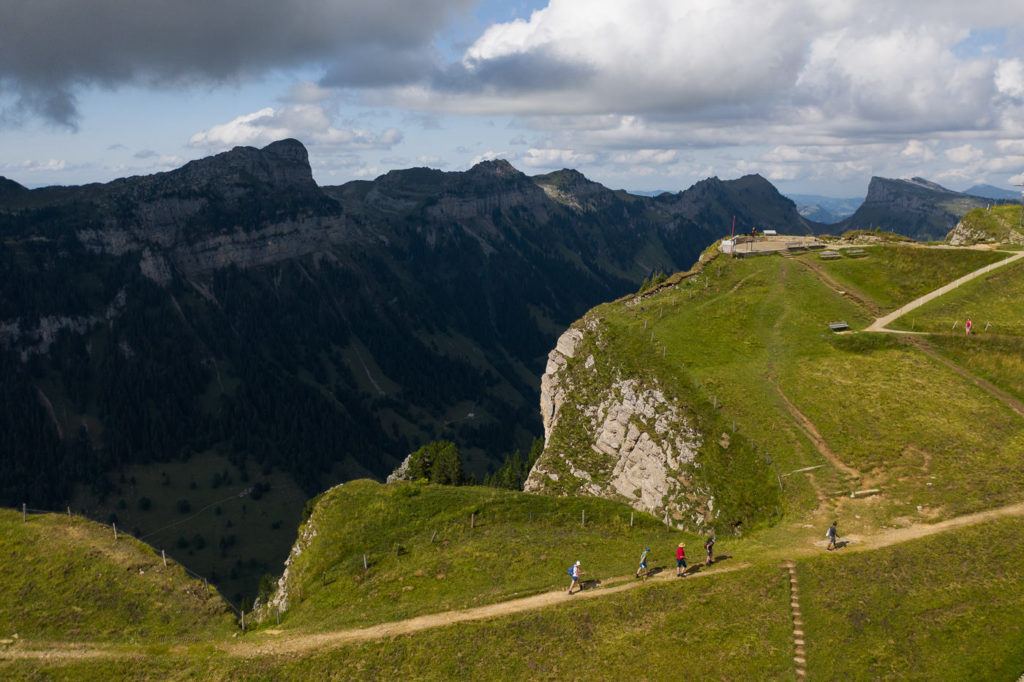
HOW TO GET TO THE NIEDERHORN HIKE
Whether you hike or take the cable car up you need to head to the Beatenbergbahn (Beatenberg Station). Then you will either hike the trail following the yellow signs or jump in a cable car. At the summit, you can hike along the ridge, which is also well-signed.
If you have the Swiss Half-Card you will receive a huge discount on your tickets. I bought mine when I arrived in Switzerland and it has saved me over a thousand dollars throughout my trip.
GET A SWISS TRAVEL PASS!
Enjoy UNLIMITED train, boat, and bus rides in Switzerland for up to 15 days. Click to book a flex Swiss Travel Pass or choose the Consecutive Swiss Travel Pass.
The Swiss Travel Pass starts at $260 for 3 days. Click here to check if it’s available on your travel dates.
MY EXPERIENCE ON THE NIEDERHORN SUMMIT RIDGE HIKE
Normally we would hike up and take a cable car down but after a big couple of days on the trails in a row, we headed out to Niederhorn and jumped on a cable car and headed up. Our plan was to hike along the ridge and then hike all the way back down to Beatenberg Station where we had parked the car.
When we reached the summit, we began to explore the ridges in all directions. To our surprise, most people clustered at one viewpoint or inside the restaurant. We hung out on the ridge that overlooks the western end of Lake Thun and was all by ourselves the entire time.
We watched as paragliders took off (I watched that one from my drone, which was a little scary), scoped out Lake Thun, and looked at the small huts in the valley below.
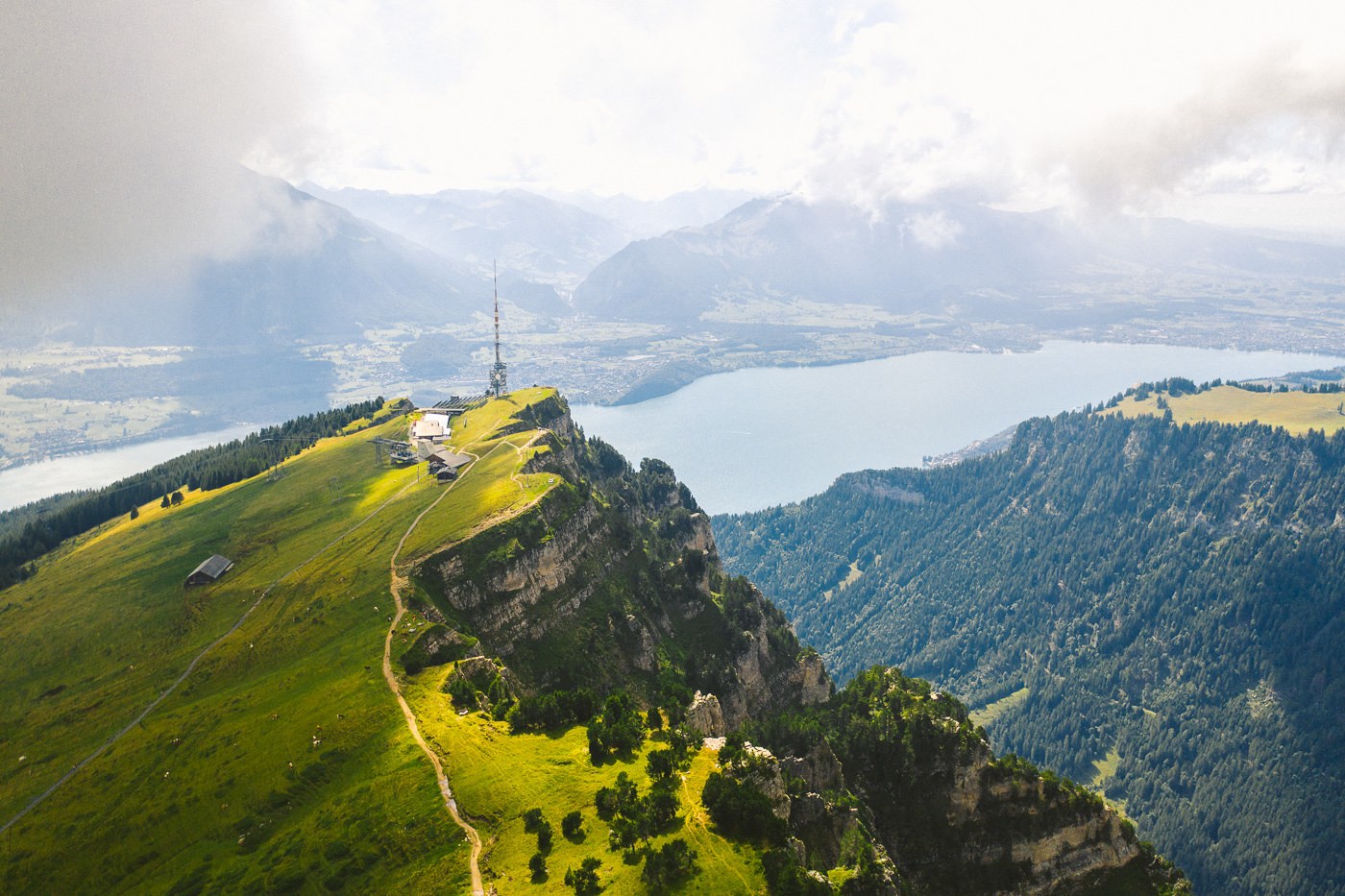
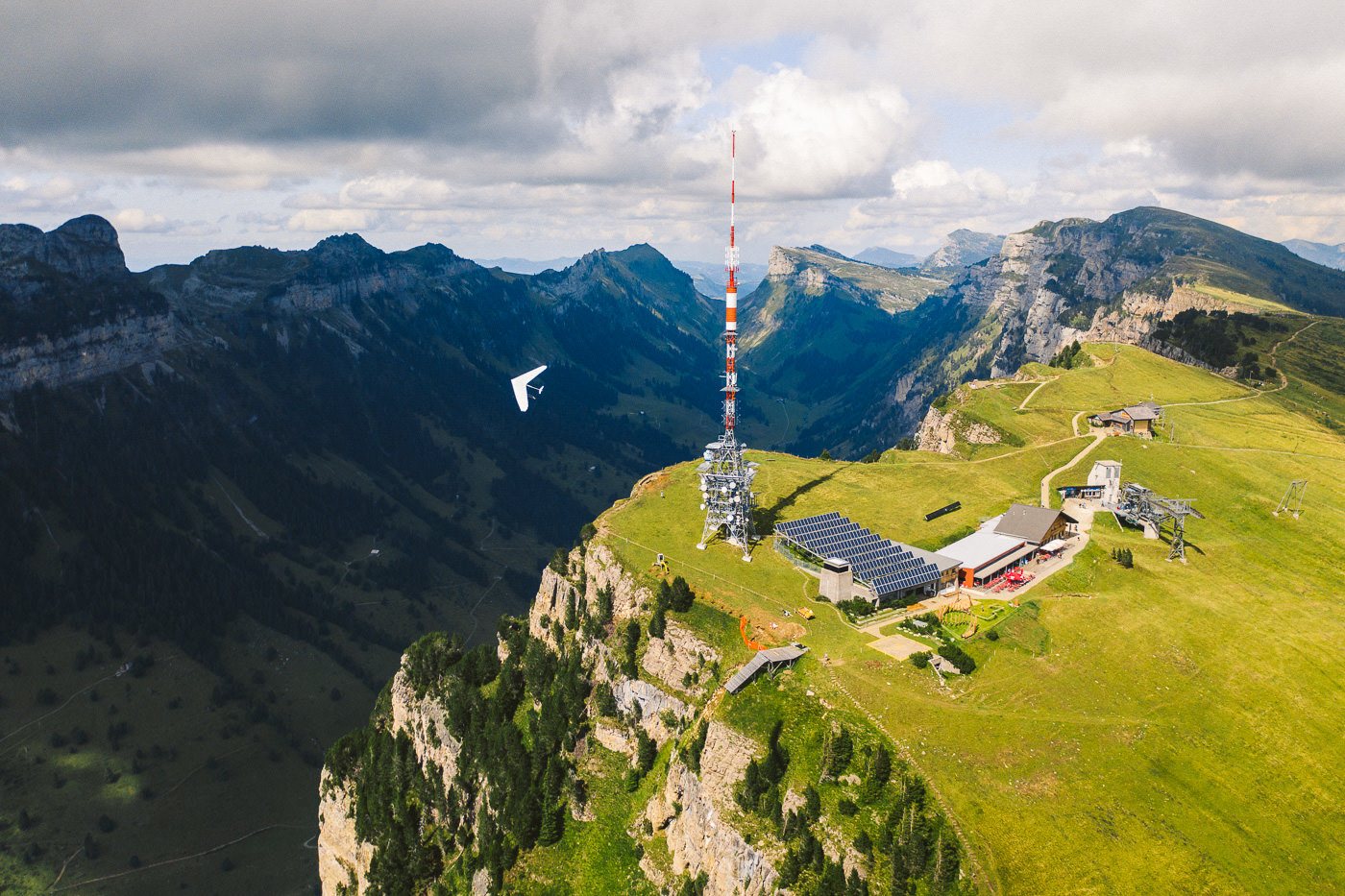
There were lots of different viewpoints around the restaurant, which are great to explore before really heading off down the ridge on the trail. Plenty of benches make it a really relaxing summit as there is just so much room to find your own space and your own view compared to some summits that are crowded and quite ‘cozy’.
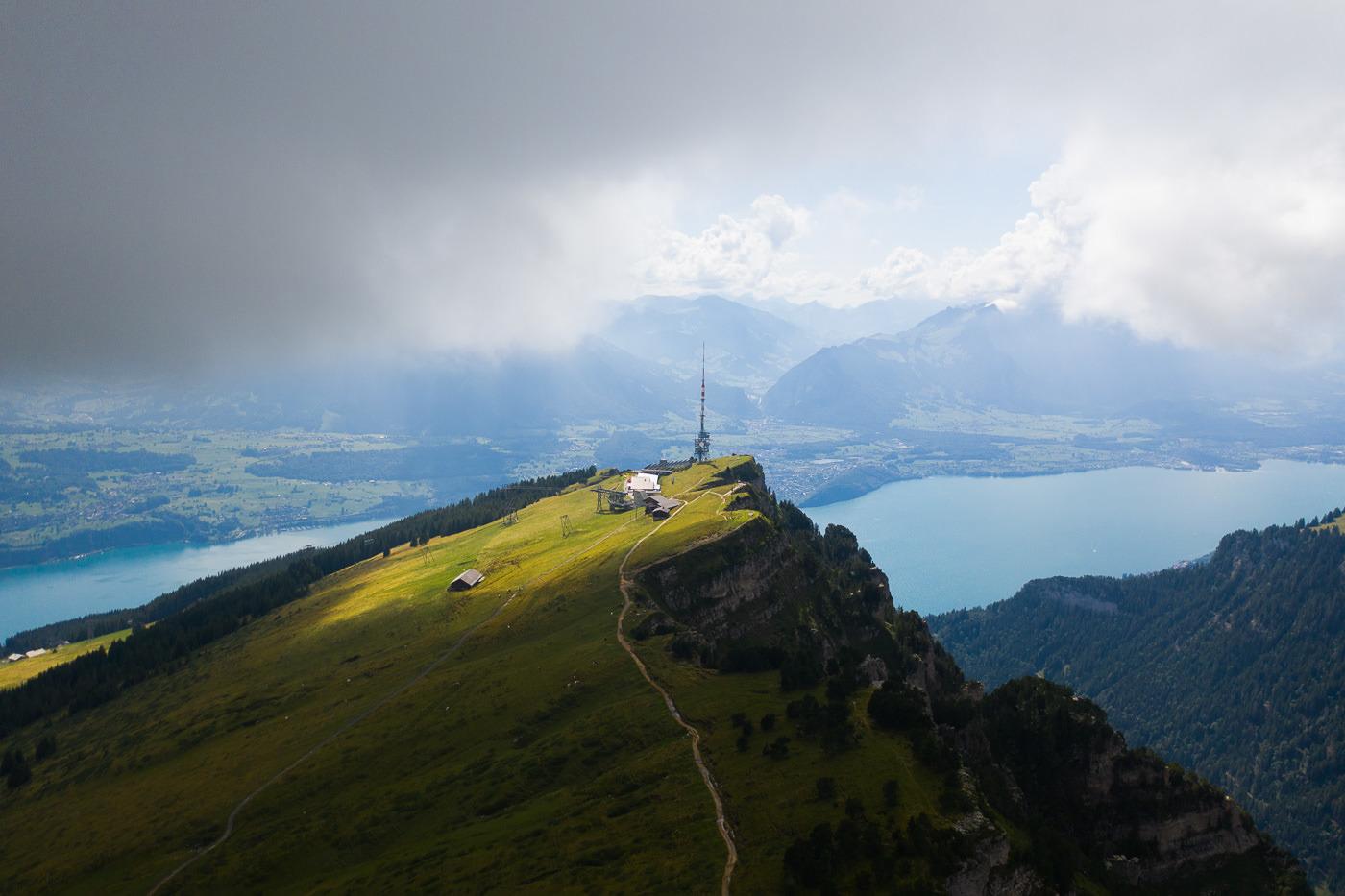
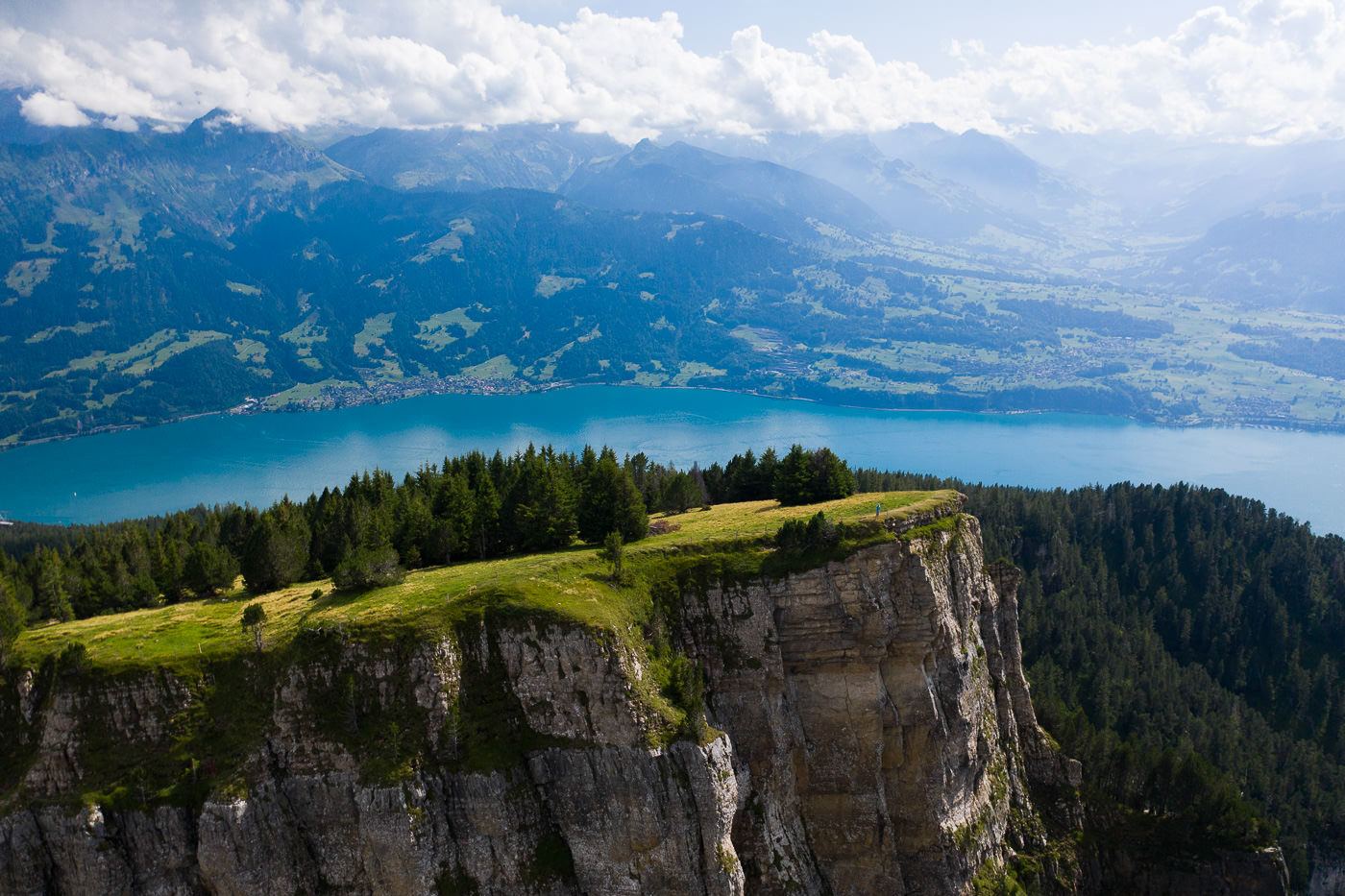
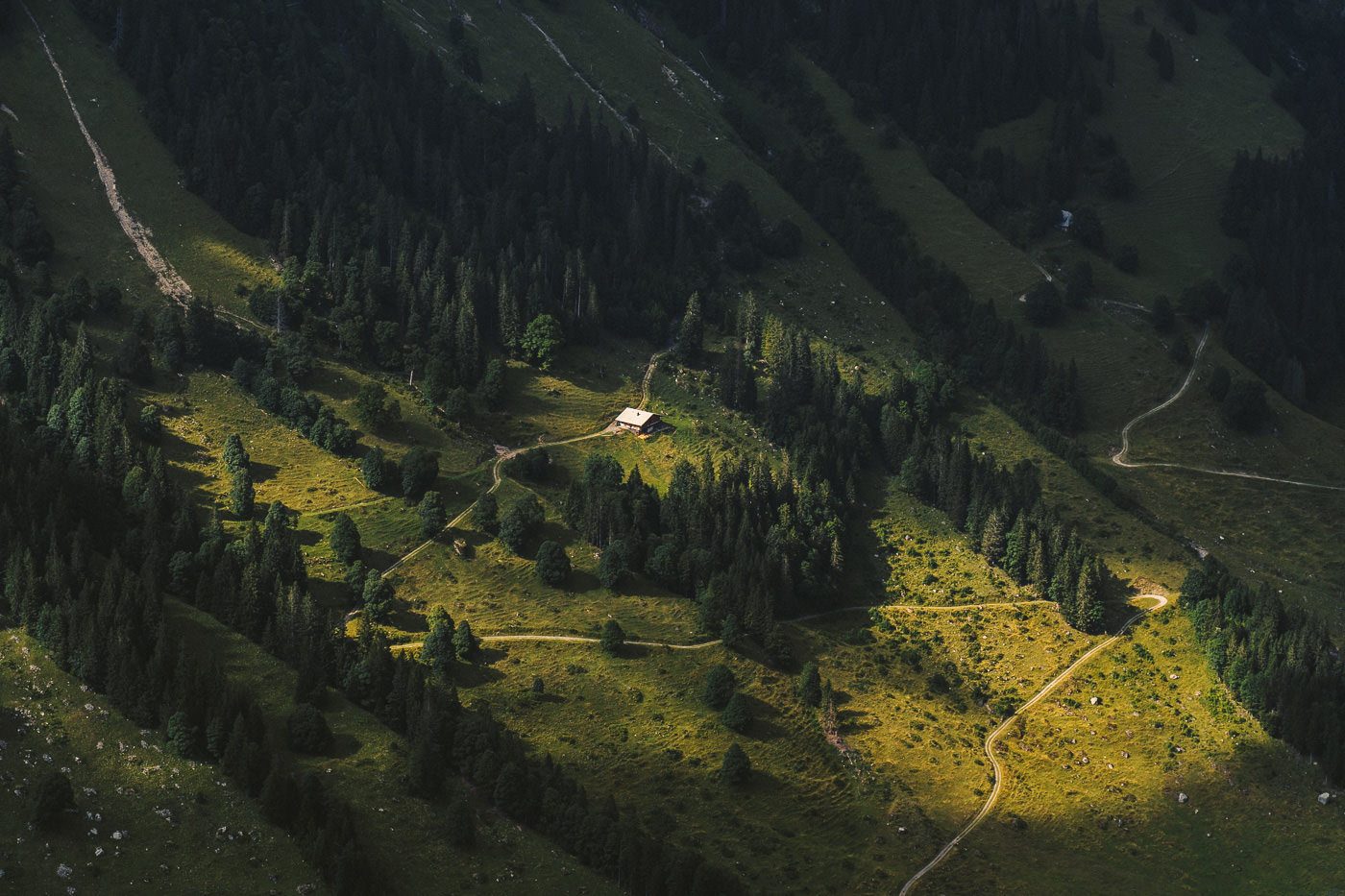
After hanging out at the summit for over an hour taking it all in, we headed off down the ridge. The route most people take at this point is Niederhorn – Burgfeldstand – Alp Oberburgfeld – Vorsass. However, we decided not to head back to Vorsass and just continue hiking all the way down to Beatenberg Station.
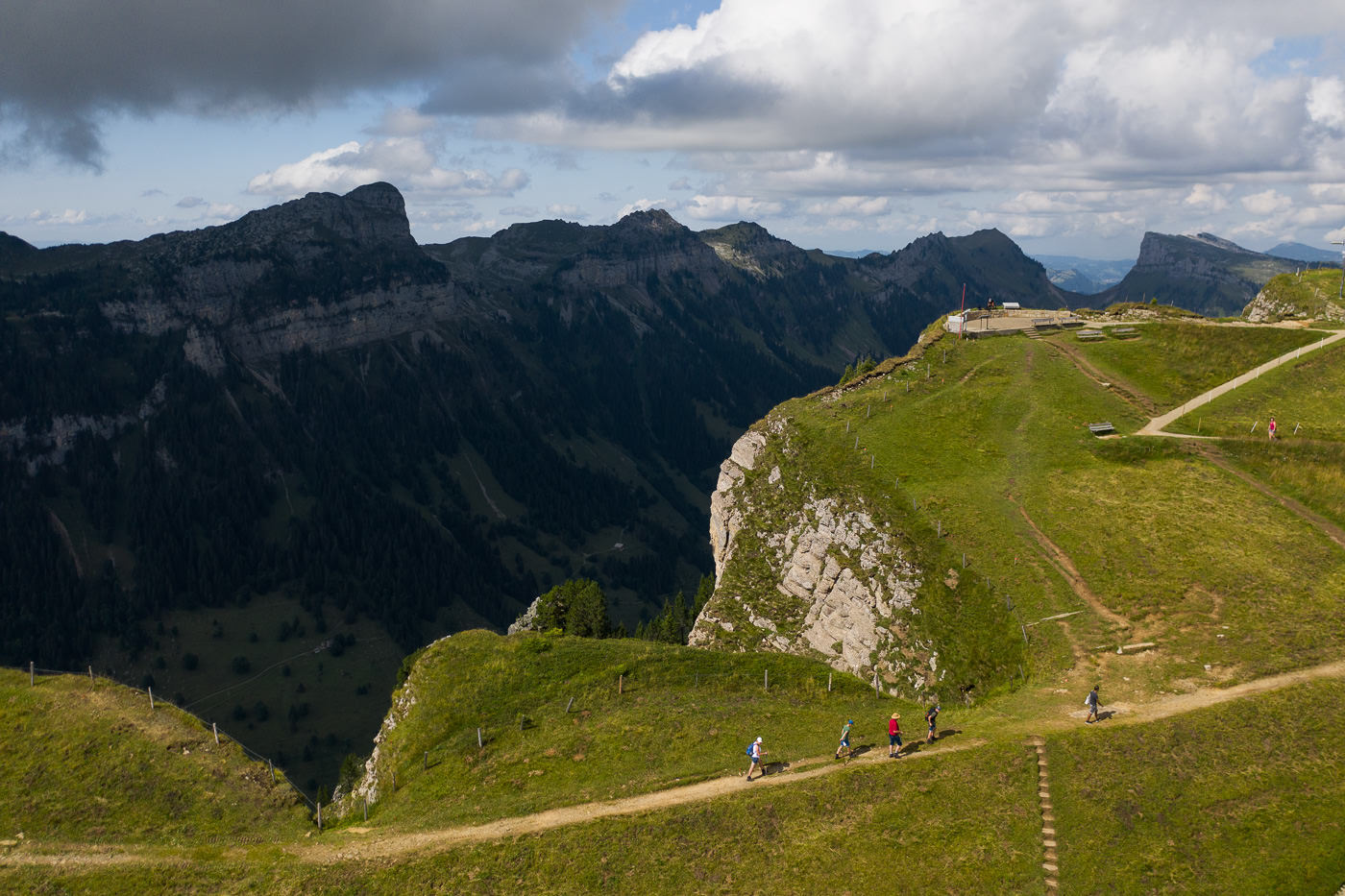
Along the way, we met some cows that were a bit too friendly. One of them took a liking to Josh.
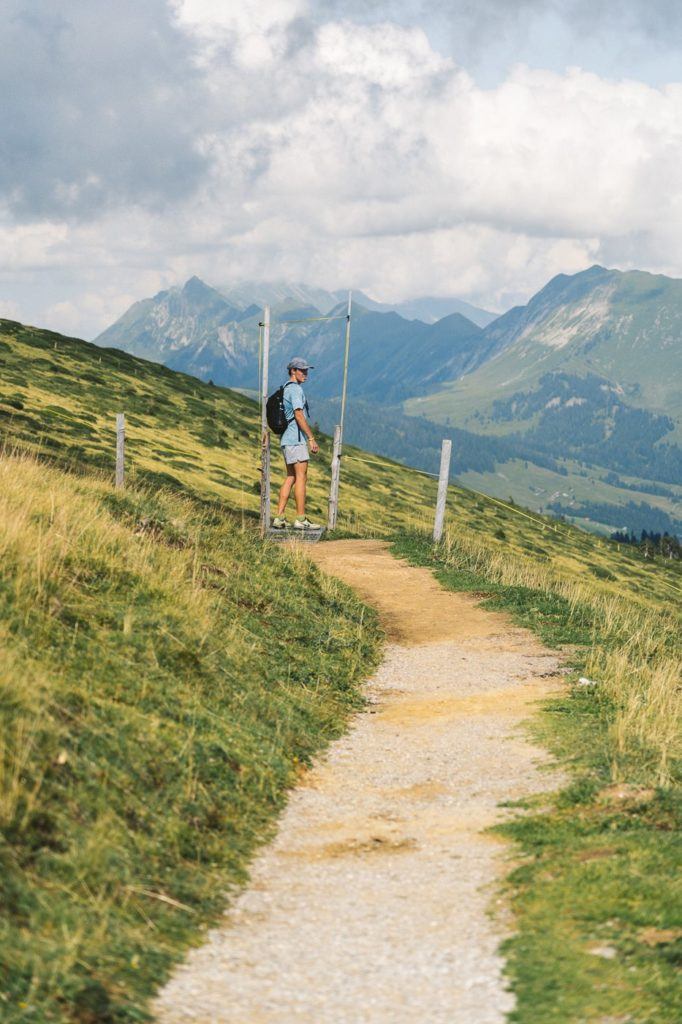
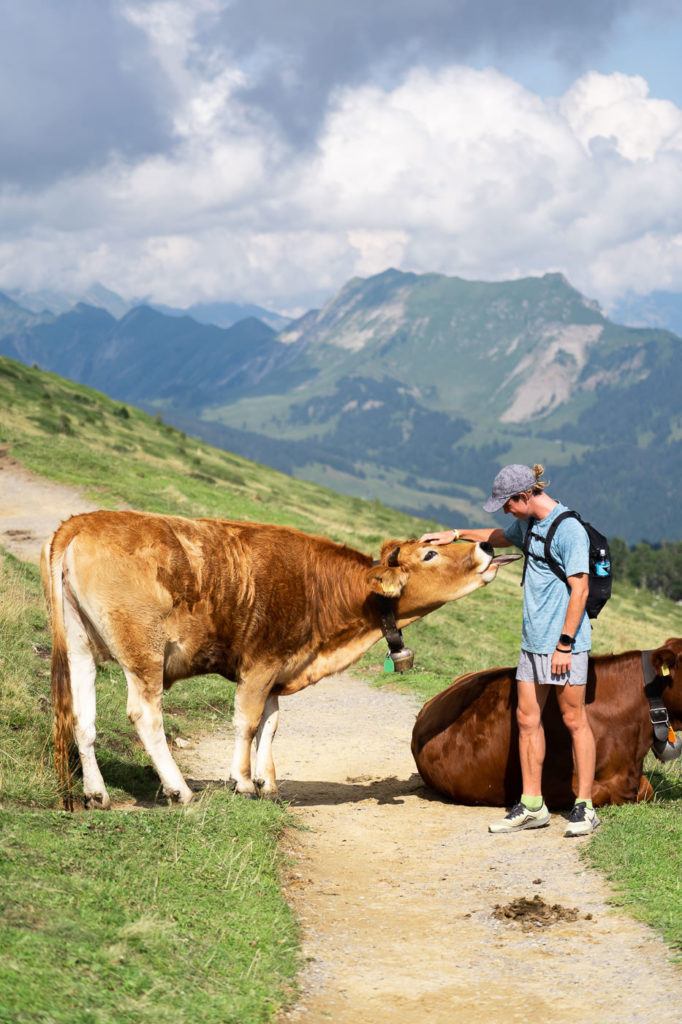
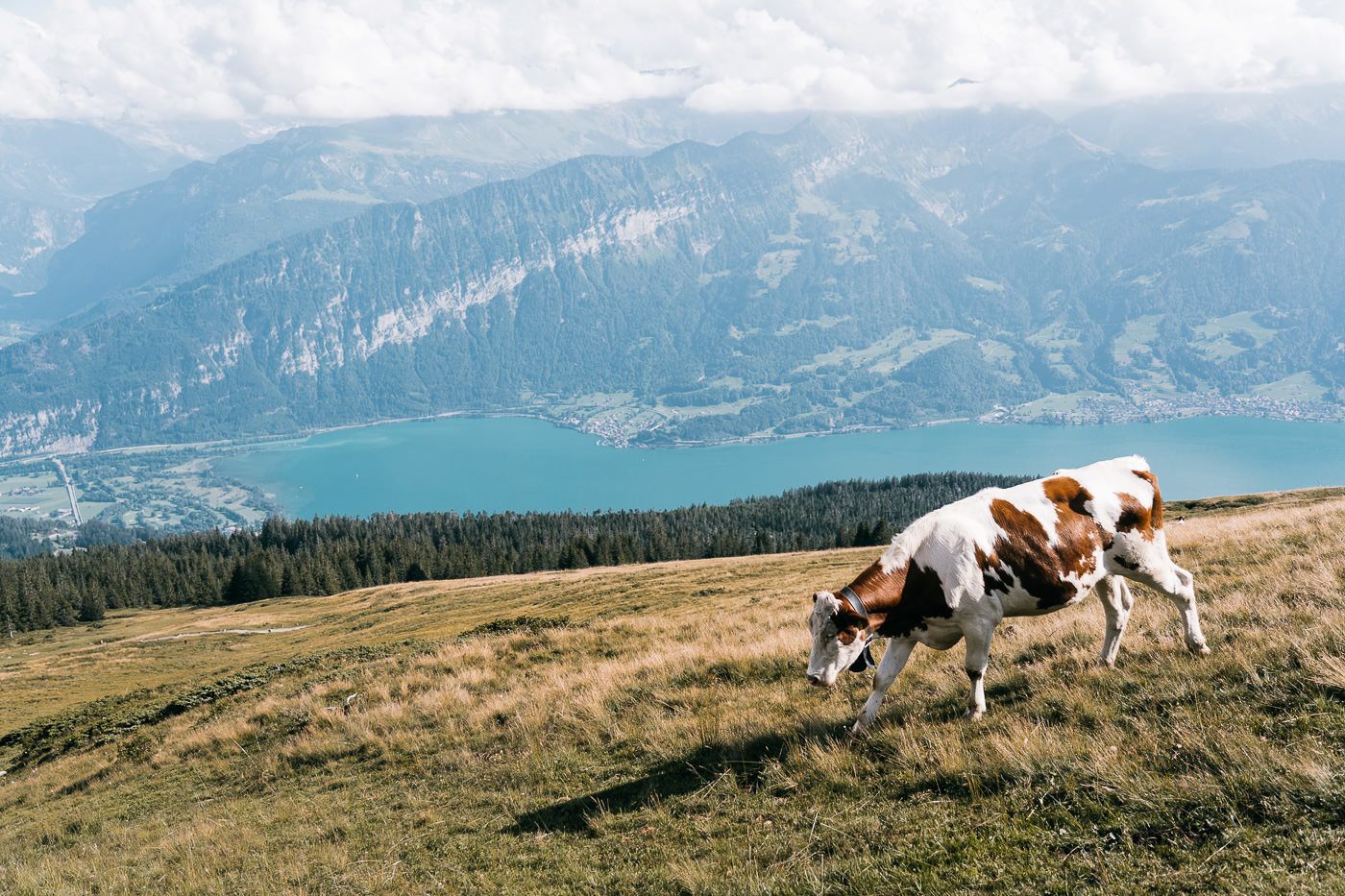
The Niederhorn is a popular region for paragliders and hang-gliders so expect to see them flying through the valley or above Lake Thun. We even watched a couple of them have some pretty sketchy take-offs.
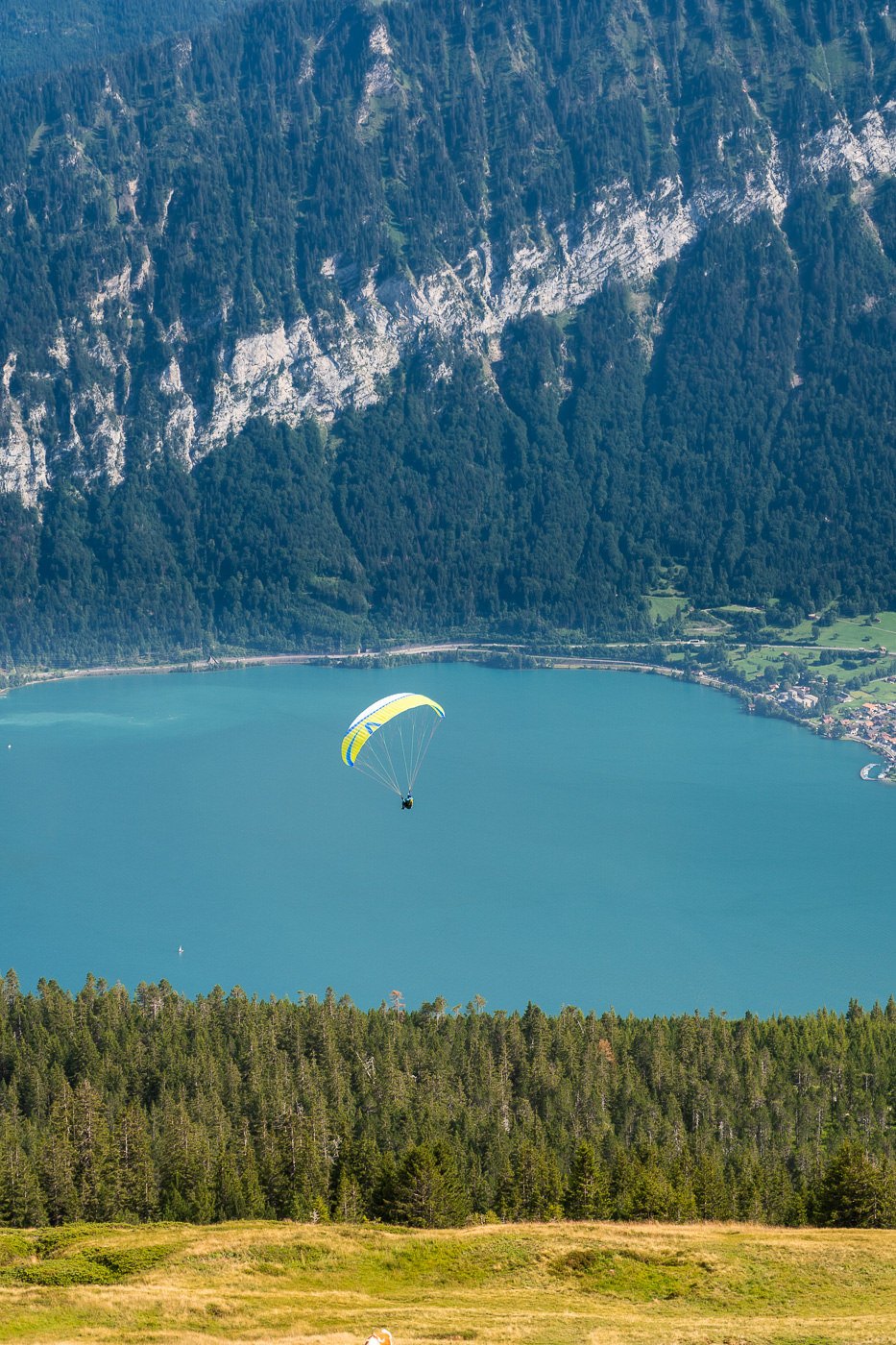
Your end goal along the ridge is Burgfeldstand, although you could keep hiking forever. That’s pretty much how it goes in Switzerland. There is always another trail connecting on and everything is connected. These photos below show the ridge to Burgfeldstand and the valley below.
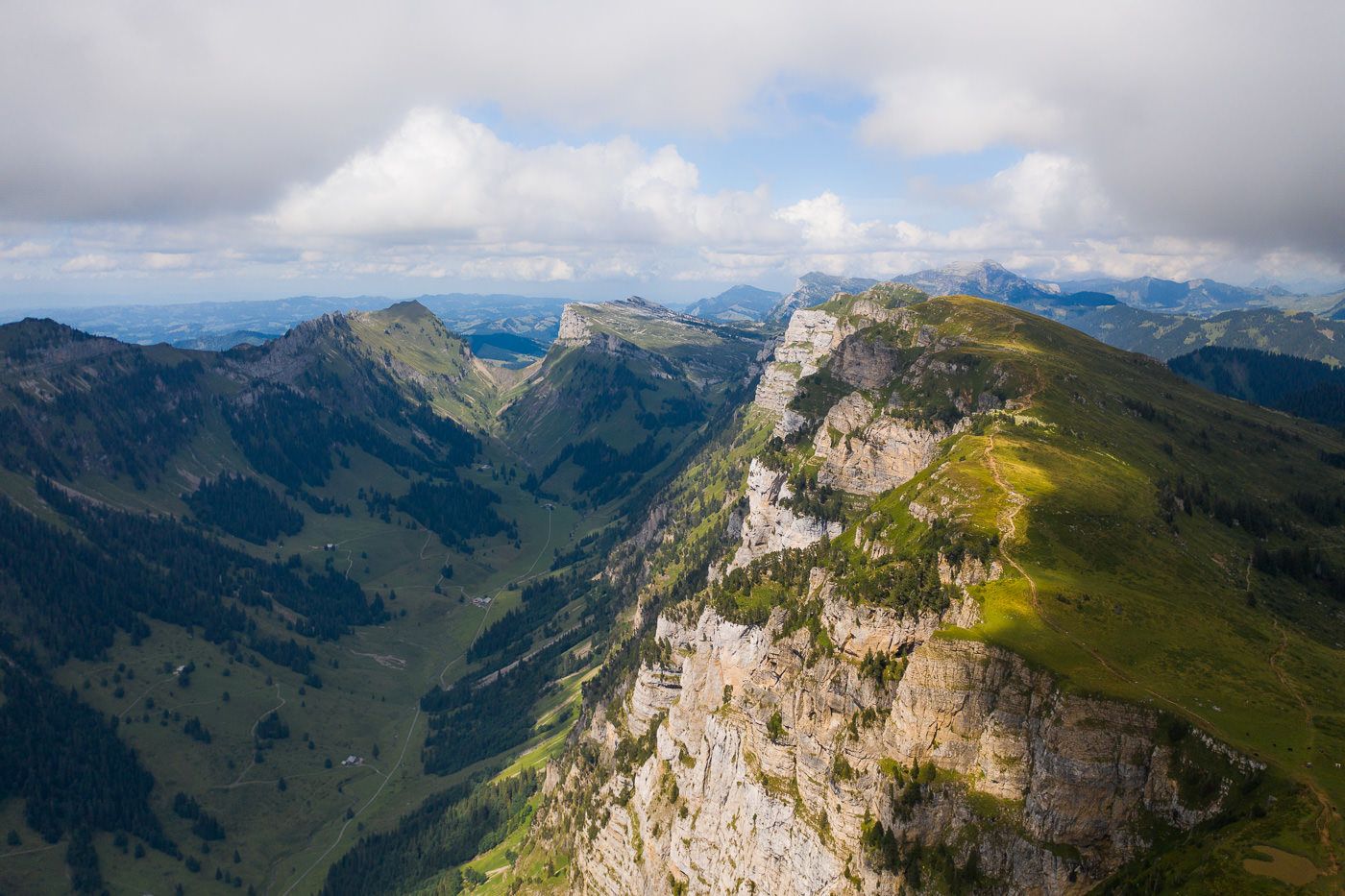
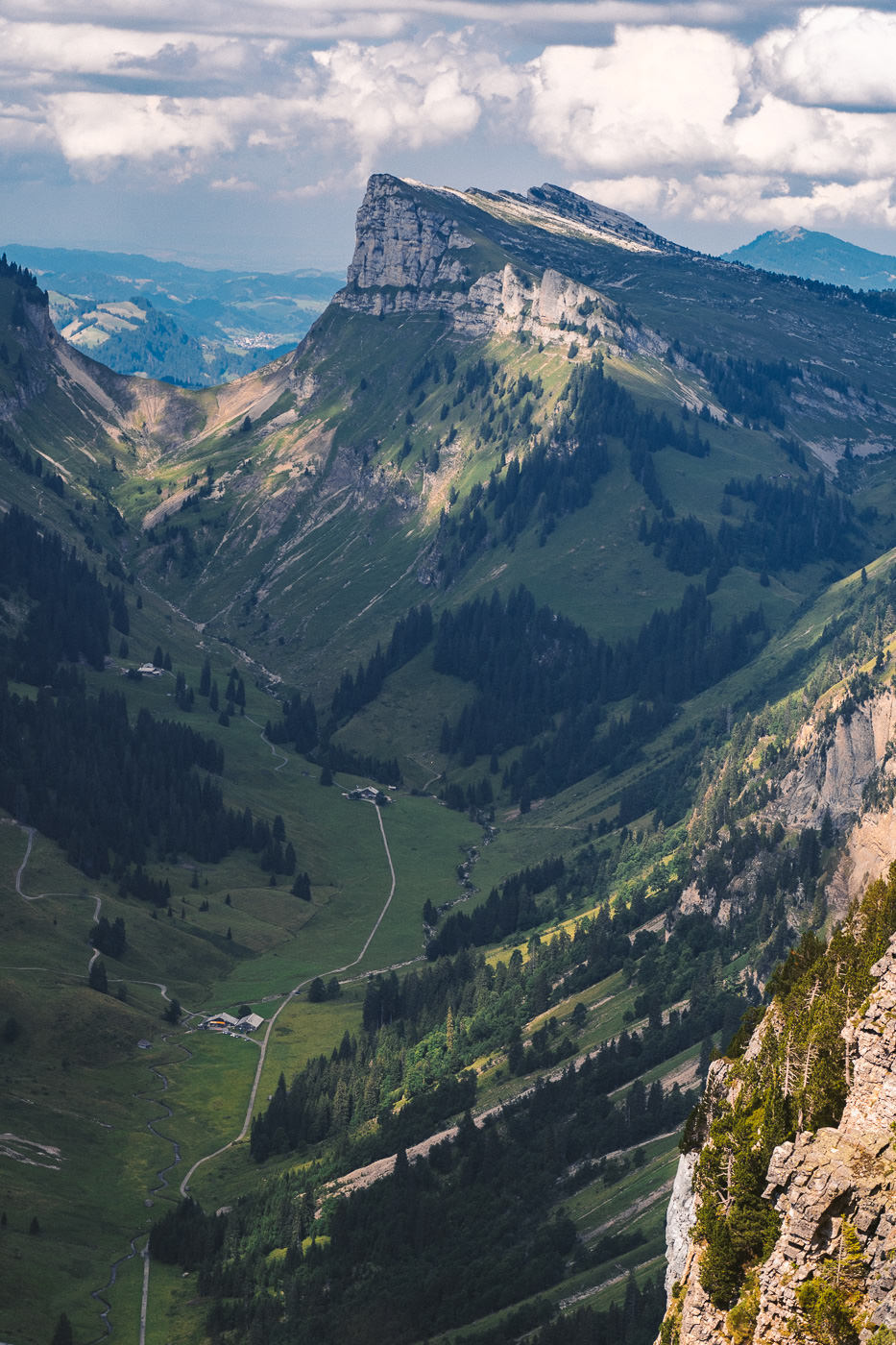
We now began the hike down and it was actually a pretty nice trail through the forest. Sometimes we cut through off-road sections and it got pretty wild but if you stay on the trail it’s a pretty simple winding route down to Beatenberg Station.
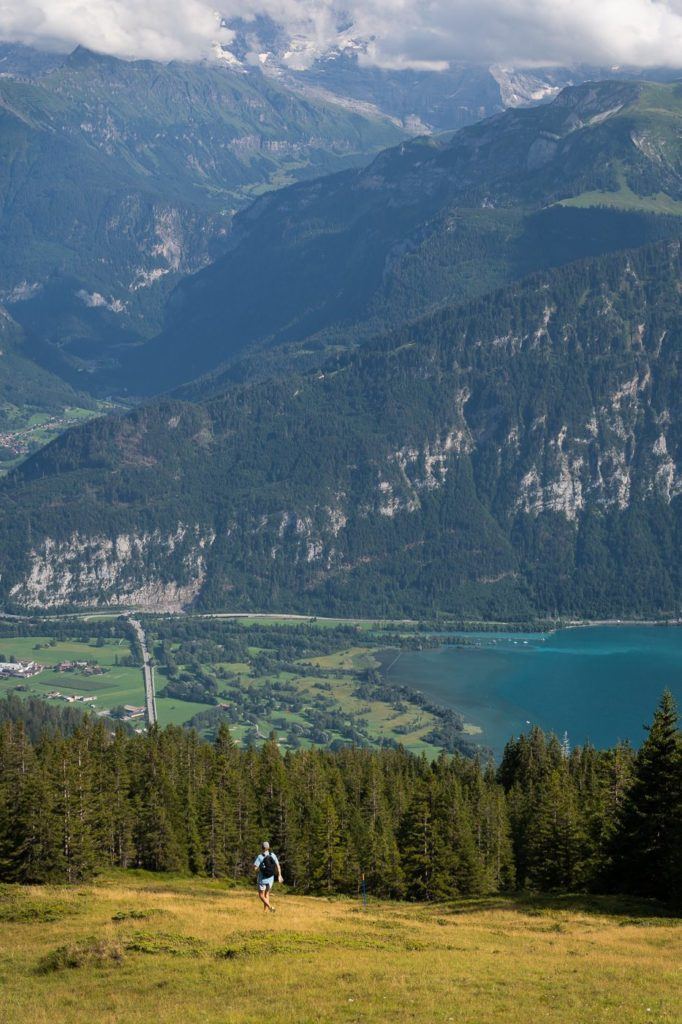
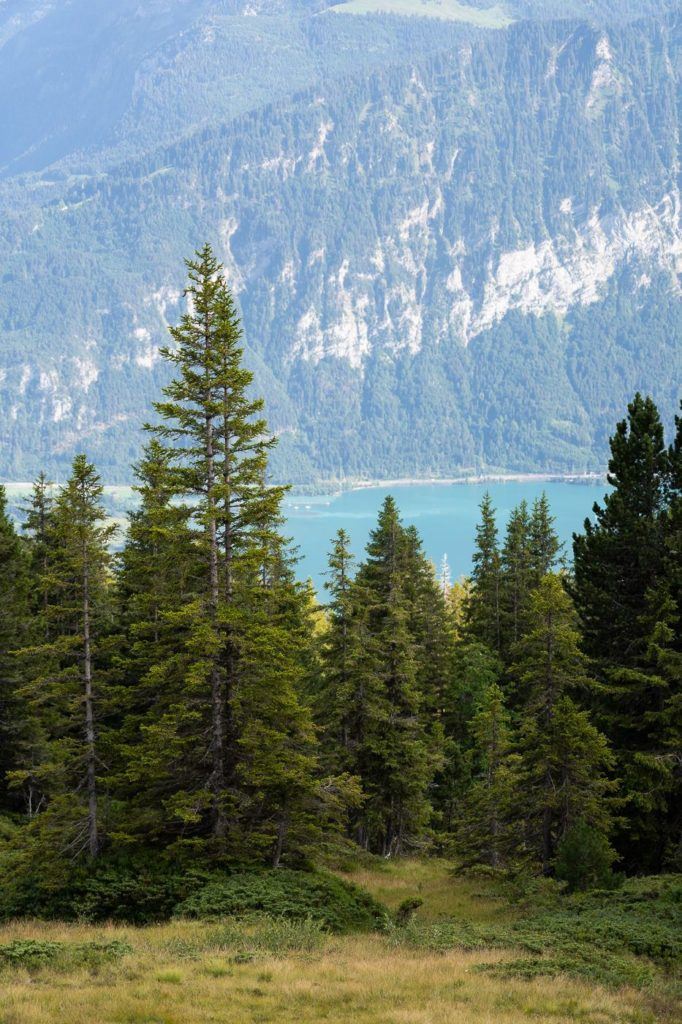
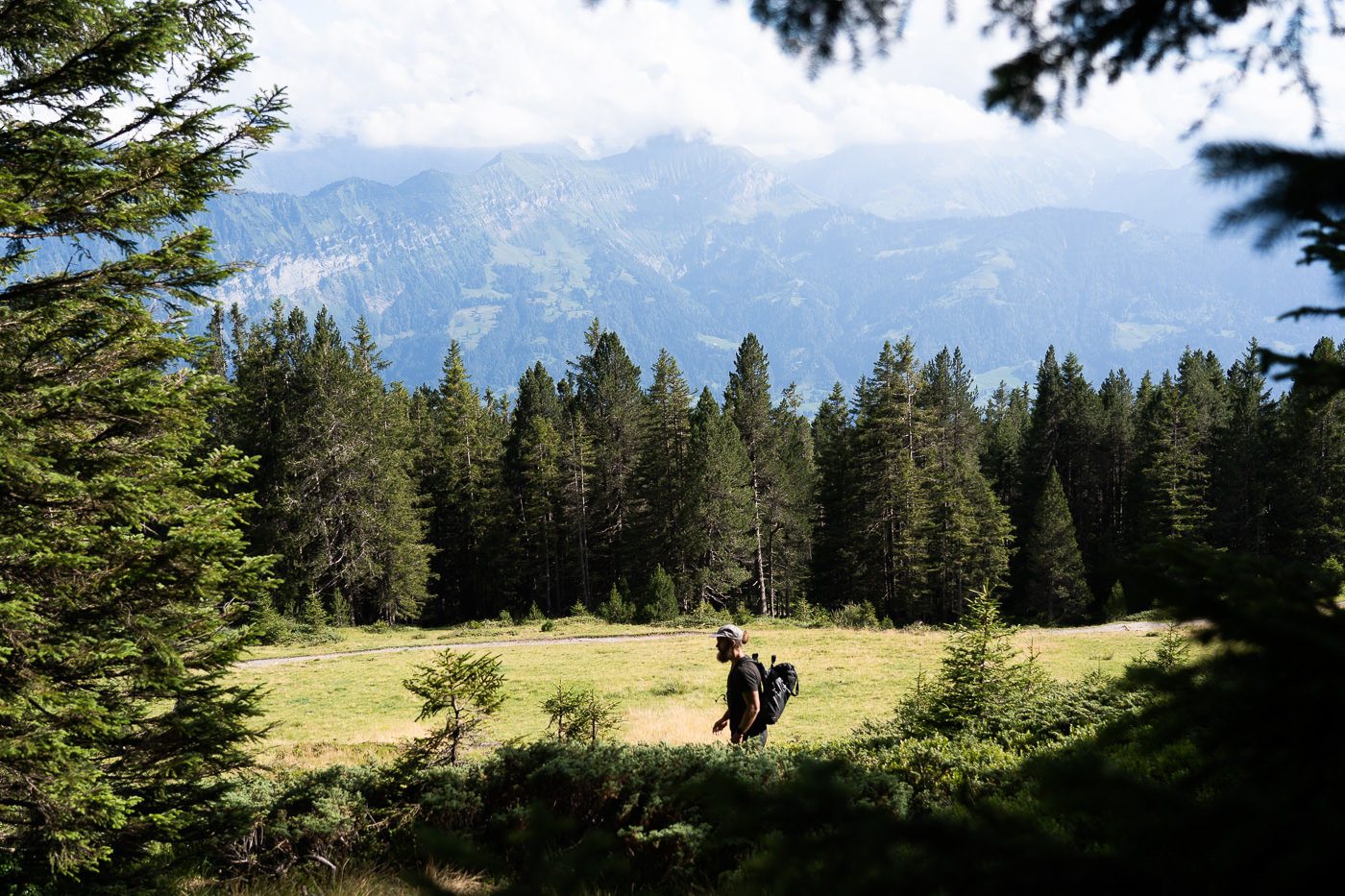
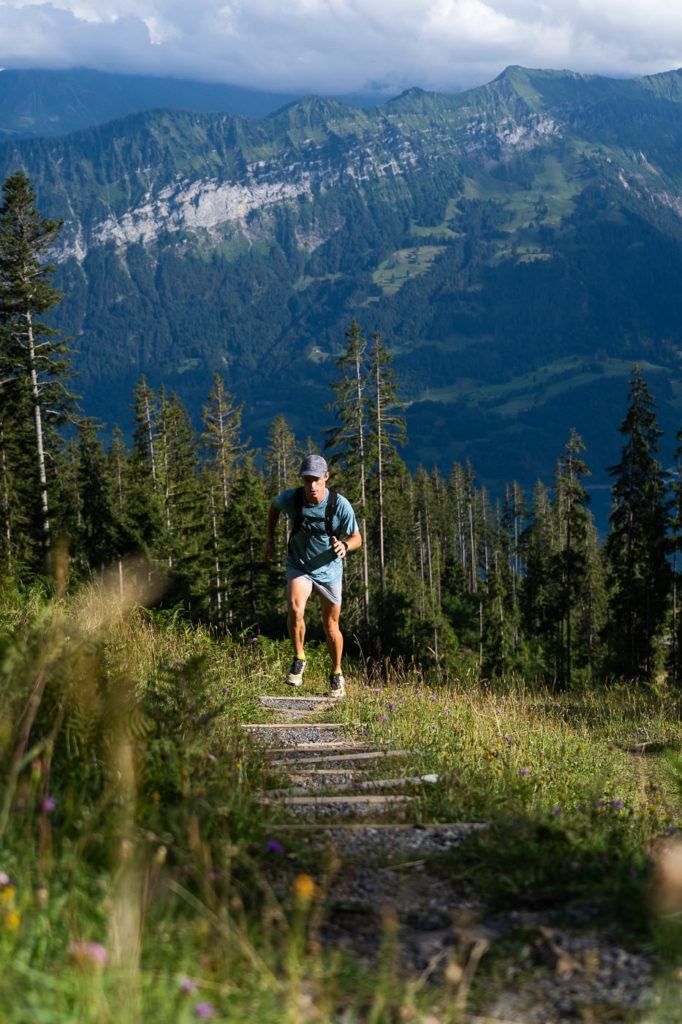
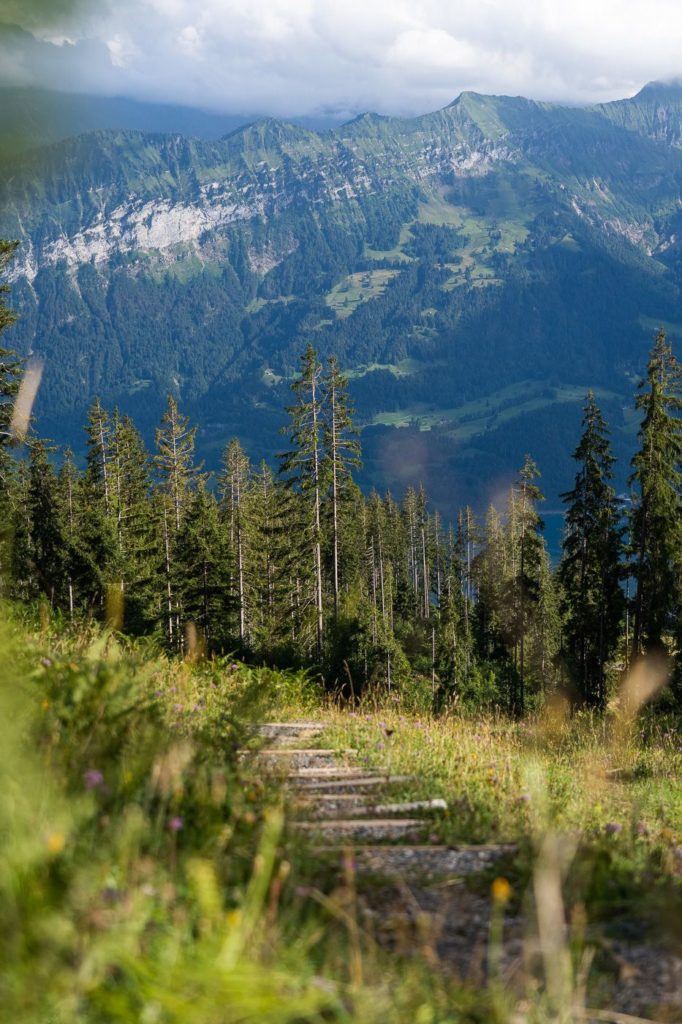
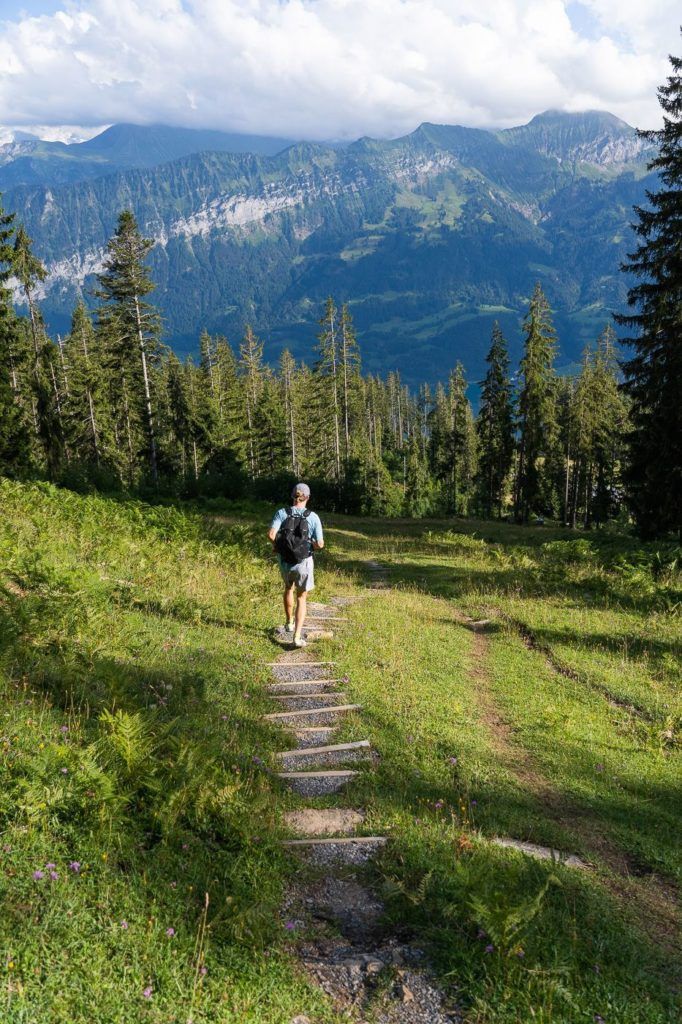
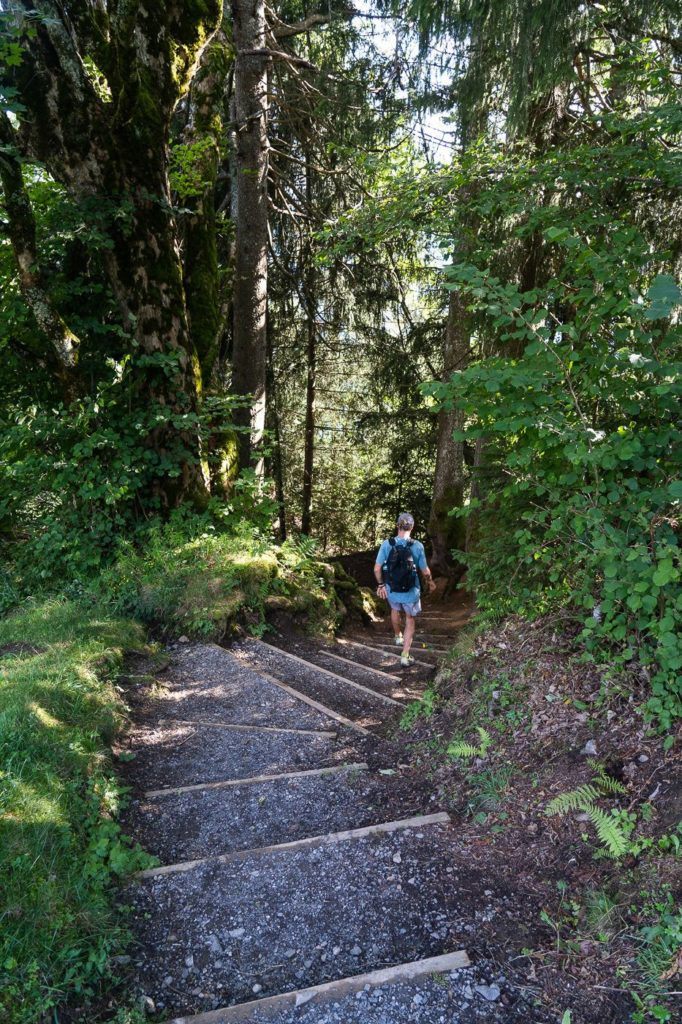
On the way down we even had some great glimpses of the mountain peaks in the Jungfrau region, which finally popped out of the clouds.
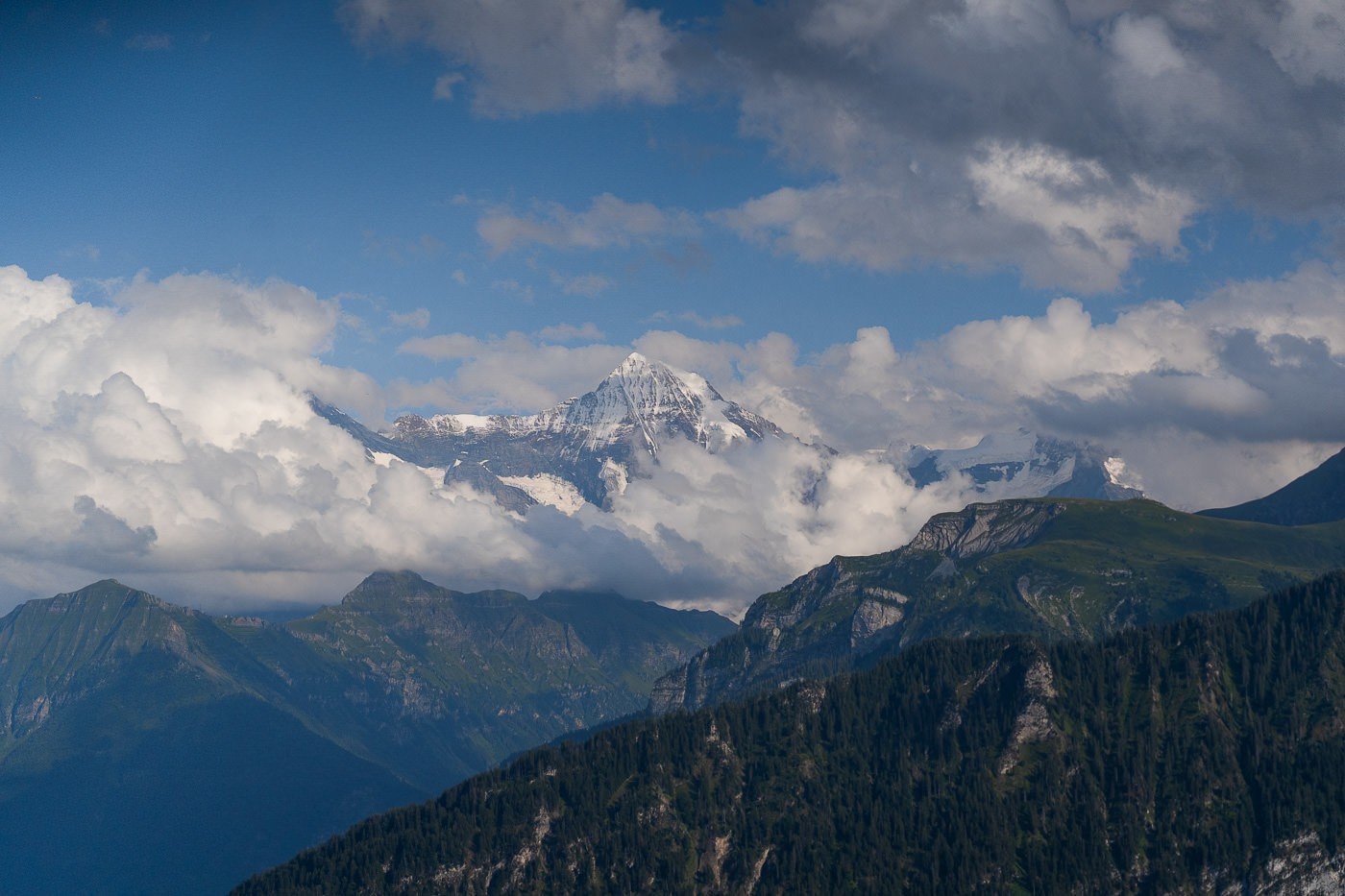
This is a great hike for families or just a slower down out on the mountains. It would be an EPIC spot for sunset and not a hard hike down in the dark so I do suggest taking the cable up (or hike up), having a bite to eat, watching the sunset, and then hiking down in the dark. That would be the ideal adventure at Niederhorn.
THINGS TO KNOW ABOUT NIEDERHORN HIKE
- Stunning Wildlife: The Niederhorn area is known for its rich wildlife, including ibexes, marmots, and even the occasional chamois. A quiet and observant hiker might be rewarded with these amazing wildlife sightings, offering a unique opportunity to witness these animals in their natural habitat.
- Panoramic Views: The Niederhorn summit provides a breathtaking panorama. On clear days, you can see over 200 peaks, including the famous trio: Eiger, Mönch and Jungfrau, along with the sparkling Lake Thun below, making it a photographer’s paradise.
- Accessible All Year Round: The Niederhorn hike is accessible throughout the year, with each season offering a unique experience. Whether it’s the blooming wildflowers in spring, the lush green trails in summer, the stunning fall colors, or the snow-capped winter landscape, the hike never loses its charm.
- Adventure Sports: Apart from hiking, the Niederhorn is also a hotspot for various adventure activities. In winter, it turns into a skiing and snowboarding destination. During summer, paragliding and downhill scooter biking attract thrill-seekers from around the world.
- Historical Significance: The area around Niederhorn has historical importance dating back to the Stone Age. The region, known as the Beatenberg-Niederhorn-Justistal, has been designated as a federal hunting reserve since 1875. It is believed that ancient hunters used this area due to the rich fauna, and evidence from prehistoric times has been found during various archaeological excavations.
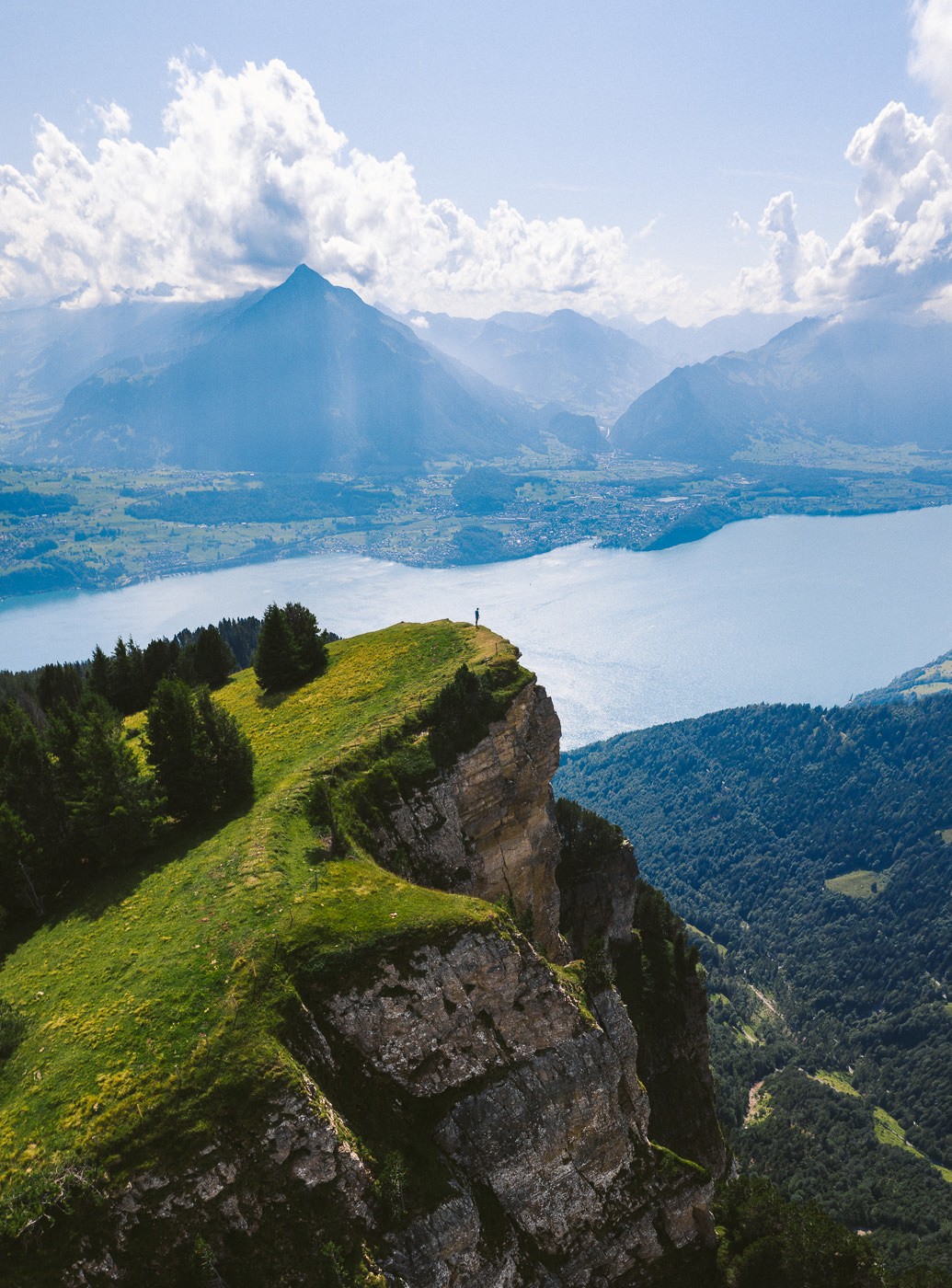
SWISS TRAVEL PASS or HALF-FARE CARD
OPTION 1: Buy the Swiss Half Fare Card: Switzerland trains, buses, and cable cars are EXPENSIVE! I found the best way to get around cheaply was to buy the Swiss Half-Fare Card before I arrived. It gives you 50% off every regular train, bus, and even many cable cars. It only costs $150 USD but pays itself off in just a few days with many train tickets in Switzerland costing close to $100 alone. If you are staying for more than 5 days, I suggest buying the Swiss Half-Fare Card.
OPTION 2: Buy the Swiss Travel Pass: The second option is to get the Swiss Travel Pass, which gives you unlimited train, bus, and (many) cable car rides but it’s pretty expensive at around $100 USD per day so if you don’t travel each day it isn’t worth it.
OPTION 3: Buy the FLEXI Swiss Travel Pass: The final (BEST) option is to get the FLEXI Swiss Travel Pass, which allows you to buy 8 days’ worth of transit but you can choose the night before if you want to activate the next day. That way you don’t need to travel every day to get your money’s worth, you can just activate the FLEXI Swiss Travel Pass on the days when you are doing sizeable transits. My advice is to book the Swiss Half-Fare Card or the FLEXI Swiss Travel Pass in advance before your trip so it’s ready to go when you arrive.
GET A SWISS TRAVEL PASS!
Enjoy UNLIMITED train, boat, and bus rides in Switzerland for up to 15 days. Click to book a flex Swiss Travel Pass or choose the Consecutive Swiss Travel Pass.
The Swiss Travel Pass starts at $260 for 3 days. Click here to check if it’s available on your travel dates.
MY SWITZERLAND HIKING GUIDES
I spent 100 days hiking in Switzerland and created a guide for different regions around the country. You can click on one of my Switzerland hiking guides below to help you plan your trip.
- The Complete Guide: 50 AWESOME HIKES IN IN SWITZERLAND
- The Via Ferrata Guide: 4 EPIC SWITZERLAND VIA FERRATA COURSES
- Lauterbrunnen Guide: 10 AWESOME HIKES NEAR LAUTERBRUNNEN
- Interlaken Guide: 15 AWESOME HIKES IN INTERLAKEN
- Grindelwald Guide: 12 AWESOME HIKES NEAR GRINDELWALD:
- Mürren Guide: 7 AWESOME HIKES IN MURREN
- Appenzell Guide: 9 AWESOME HIKES NEAR APPENZELL
- Chur Guide: 7 AWESOME HIKES NEAR CHUR
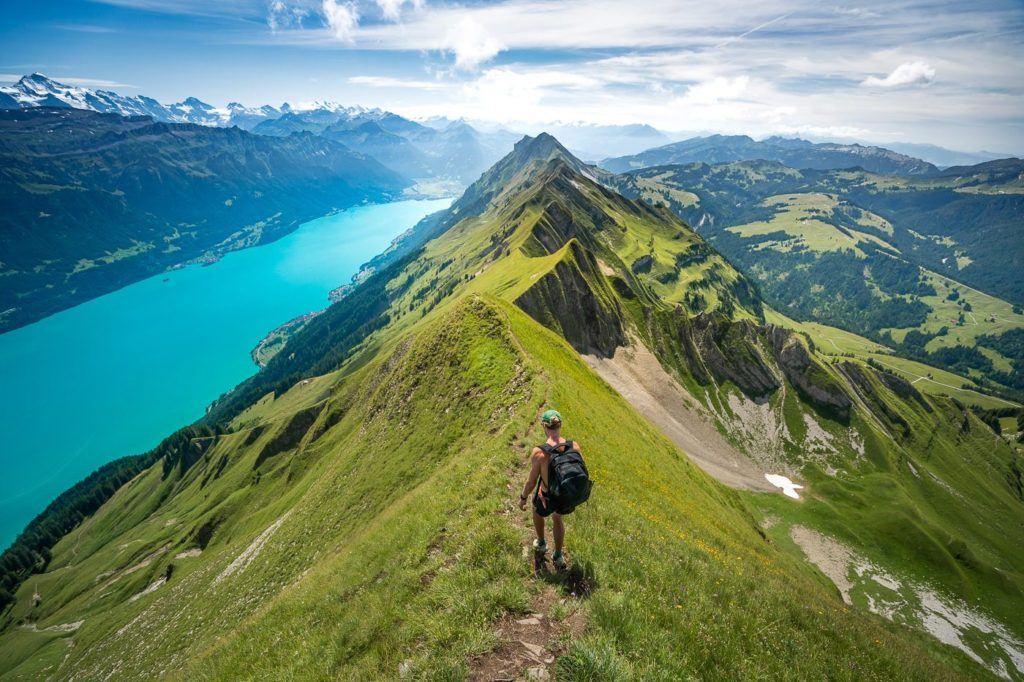
MY SWITZERLAND TRAVEL TIPS
- For Backpackers: SWITZERLAND BUDGET BACKPACKING GUIDE
- Travel Tips: 20 THINGS TO KNOW BEFORE VISITING SWITZERLAND
- Transport Tips: RENTING AND DRIVING A CAR IN SWITZERLAND
- Accommodation Guide: 30 BEST PLACES TO STAY IN SWITZERLAND
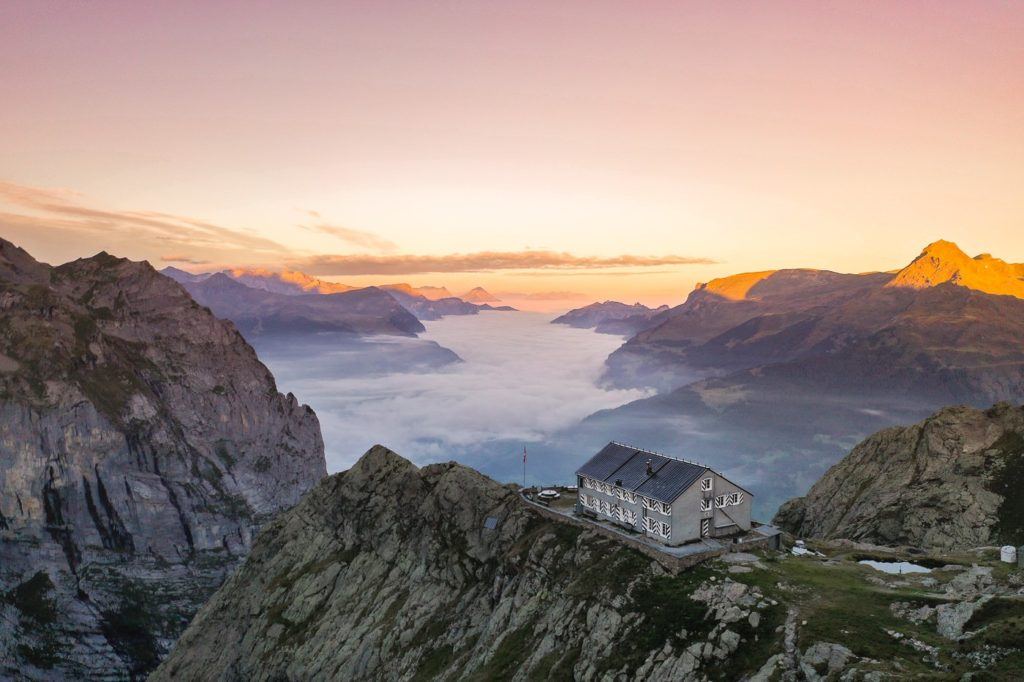

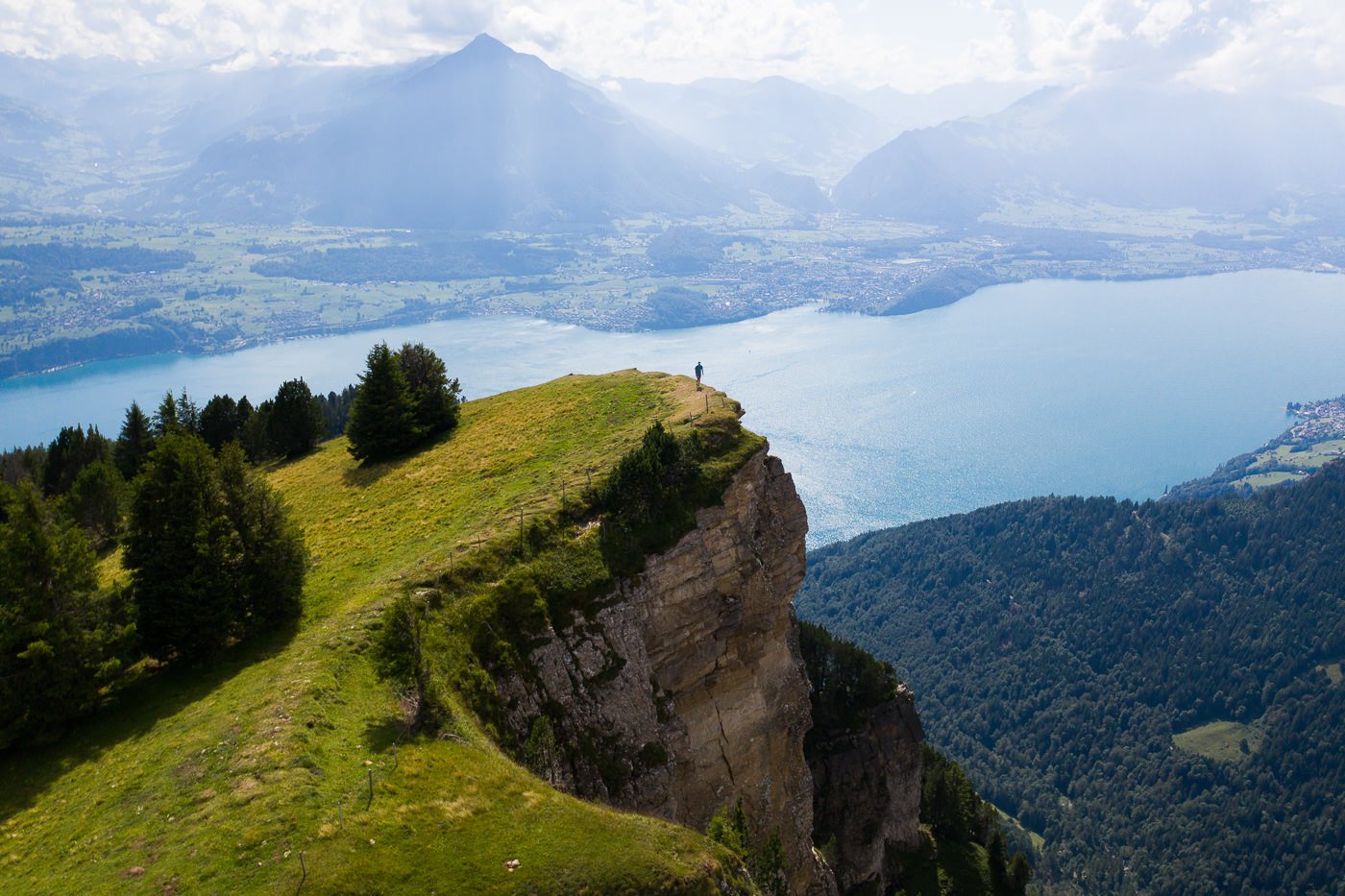
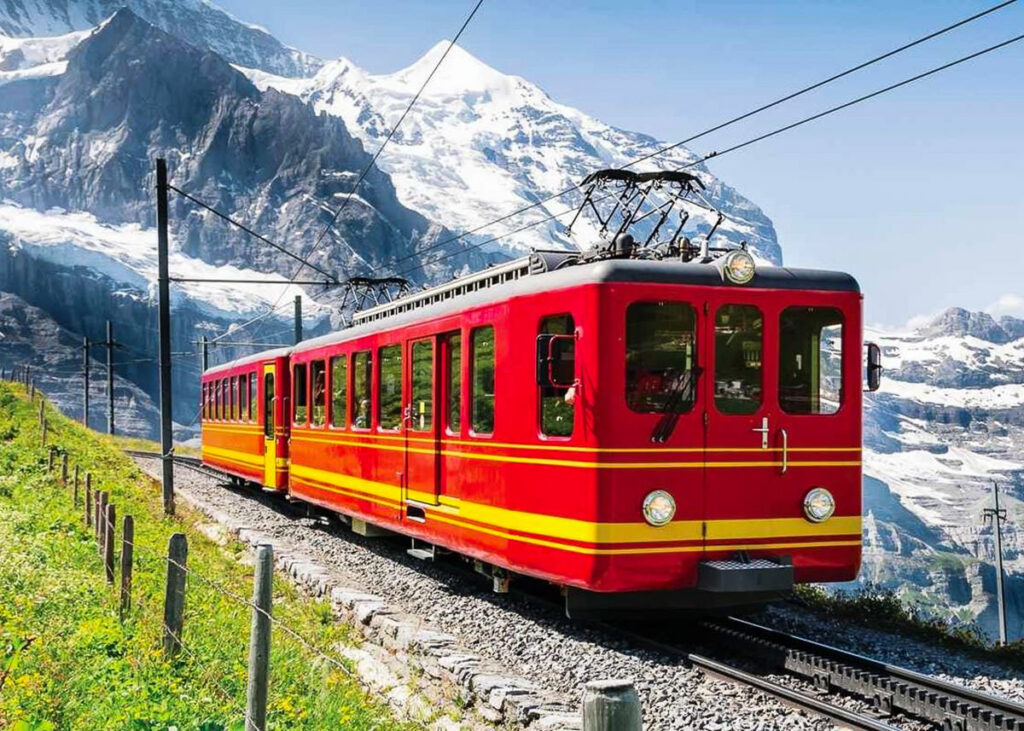
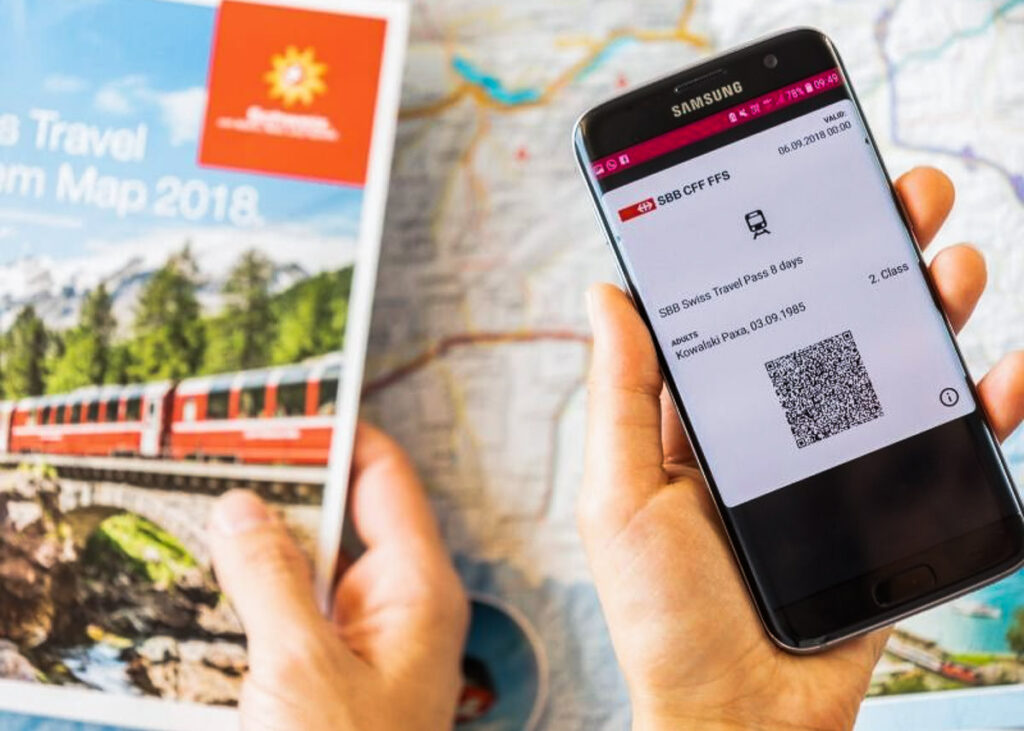
Bryan
Saturday 2nd of March 2024
Looks amazing - we are heading to Switzerland in May and might be interested in visiting Niederhorn.
One thing I am confused about is the niederhorn.ch talks about "hiking tickets". But I can't understand from the website how it works exactly, or where you would buy one - did you have to pay for any hiking ticket to do your hike? Thanks!
Jackson
Saturday 23rd of March 2024
normally in switzerland you don't need to pay to hike... just paying for gondola or cable car when you use.